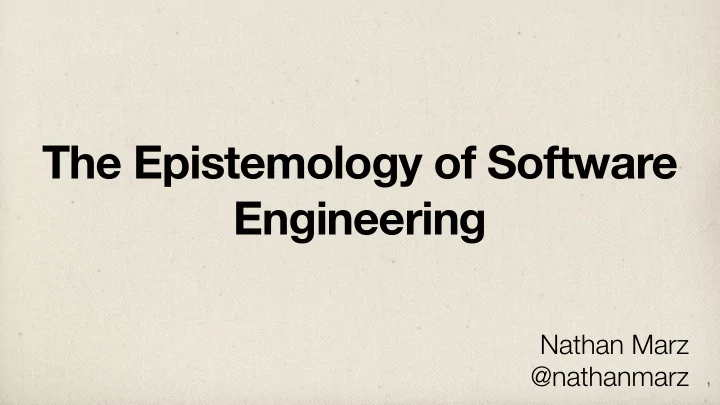

The Epistemology of Software Engineering Nathan Marz @nathanmarz 1
My personal philosophies on software development
Agenda 1. Limits of human knowledge 2. E ff ect of the limits of knowledge on software development 3. Embracing those limits enables you to build better software
How do I know my software is correct?
How do I know a proposition is true?
Epis tf molog y
How do I know my software is correct? PREVIEW
You don’t
Your code is wrong
How do I know a proposition is true? PREVIEW
You don’t
True knowledge is unattainable
But wait... philosophy?
Strawman Moral highground Appeal to authority Ad hominem attack Appeal to emotion Shotgun argumentation Circular reasoning Correlation vs causation False dilemma Equivocation Argument to moderation Burden of proof Fallacies
Your code is wrong
Your code is literally wrong
Your code is wrong
Why do you believe your code is correct?
Dependency 1 Dependency 2 Your code Dependency 3
Dependency 4 Dependency 1 Dependency 5
Dependency 6 Dependency 7 Dependency 4 Dependency 8 Dependency 9
Dependency 3,000,000 Hardware
Electronics
Chemistry
Atomic physics
Quantum mechanics
I think I can safely say that nobody understands quantum mechanics. Richard Feynman
Your code is wrong
... Your code
Infinite regress
Epistemological “solutions” 1. Infinitism 2. Foundationalism 3. Coherentism
Coherentism
Foundationalism Axioms
René Descartes
Cogito ergo sum
I think, therefore I am
Codito ergo sum
I code, therefore I am
Cartesian foundationalism 1. Limited axioms 2. Knowledge through deduction
Cartesian programming 1. Axioms = rules of programming language 2. Programs = deductions from those axioms
-> OutOfMemoryException
-> Hallo welt!
All the software you’ve used has had bugs in it
Including the software you’ve written
I nduc tj o n
f(0) and (f(n) → f(n+1)) ⇒ ∀ n ≥ 0, f(n)
I nduc tj o n
<sidenote>
David Hume
“Why is inductive reasoning valid?”
</sidenote>
S kep tj cis m
perfect code
value to users
“My software is correct”
“My software is sometimes correct”
How do you minimize imperfection?
Storm’s “reportError” method
(Storm is a realtime computation system, like Hadoop but for realtime)
Storm architecture
Storm architecture Master node (similar to Hadoop JobTracker)
Storm architecture Used for cluster coordination
Storm architecture Run worker processes
Storm’s “reportError” method
Used to show errors in the Storm UI
Error info is stored in Zookeeper
What happens when a user deploys code like this?
Denial-of-service on Zookeeper and cluster goes down
Failures! Irrelevant! Robust! Bad performance! Security holes! Designed input space Actual input space
Implement self-throttling to avoid overloading Zookeeper
Robust! Designed input space Actual input space
Robust! Designed input space Actual input space
Epis tf molog y
Trth Trut Truh Tuth Tru
Foundation of modern science
Newton’s laws of motion 1. When viewed in an inertial reference frame, an object either is at rest or moves at a constant velocity, unless acted upon by an external force. 2. The acceleration of a body is directly proportional to, and in the same direction as, the net force acting on the body, and inversely proportional to its mass. Thus, F = ma, where F is the net force acting on the object, m is the mass of the object and a is the acceleration of the object. 3. When one body exerts a force on a second body, the second body simultaneously exerts a force equal in magnitude and opposite in direction to that of the first body.
Orbit of Mercury problem Cambridge, we have a problem...
Einstein’s theory of relativity Sorry, Newton, you’ve been PWNED:
limit = truth n approximation (truth) n → ∞
Science algorithm 1. Make observations 2. Find theories consistent with those observations 3. Falsify theories by making more observations
Foundationalism + Coherentism
E mpiricis m
John Locke
Recommend
More recommend